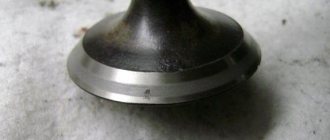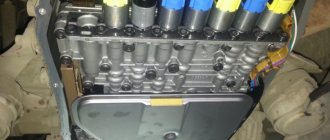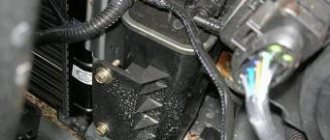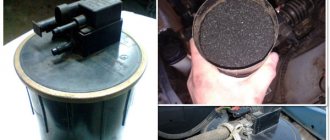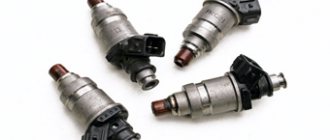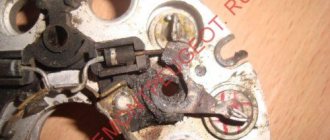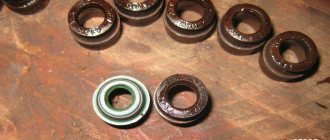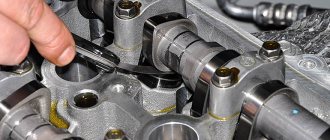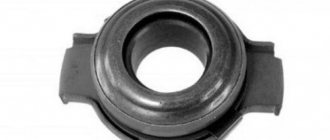The design of the gas distribution system of most internal combustion engines includes a valve system. It regulates the timely flow of air or combustible mixture into the combustion chamber and the release of exhaust gases. The valve itself constantly operates in aggressive conditions under the influence of high pressures and temperatures, which destroy the body of the part, leading to engine failure. There are certain reasons and conditions under which valve burnout occurs much faster than the design period of operation.
Causes of high temperature damage
Experts identify various factors that have a direct impact on the integrity of parts. The most popular among them are:
- Extremely high temperatures. Automakers calculate the characteristics of the unit in such a way that it functions most of the time at 600-650C. In the case where there are malfunctions of the heat sink, excessive overheating is fraught with destruction.
- Manufacturing defects. Although all parts leaving the factory assembly line undergo strict control, there remains a low risk of defective parts. It can be determined independently by the heterogeneity of the metal, microcracks, defects in welding seams, etc.
- Low quality fuel. Running a lean fuel mixture may be the reason why valves burn out. The lack of fuel in the mixture is ruined by temperature fluctuations.
- Availability of connected gas equipment. Engines using gas as an alternative fuel are characterized by significant loads on gas distribution systems. Power plants with a poor gas supply are at risk. We recommend calibration at least every 12-14 thousand kilometers.
A high percentage of defective spare parts is a problem for the motorist
These are not the main reasons why valves burn out. The leading manufacturer of these parts conducted a small study, and the statistics were not happy - every fifth part that is produced breaks or burns out due to the human factor and defects. And even modern product quality control at factories does not guarantee that the part is free of any defects.
Another reason is metallurgical inhomogeneities that are included in the alloy. These irregularities make the valve weaker than it should be. In addition, there are manufacturing defects, namely forging. This leads to microcracks. Errors in the heat treatment process lead to changes in the dimensions of the product.
How will the engine work and what will happen if the valves are clamped?
How to understand that the valve is jammed
If after starting the engine runs normally, but during long operation the thrust drops - this is a symptom of pinched valves. Another sign of jammed valves can be shots into the muffler when releasing gas. Because The combustion chamber is not completely closed, compression decreases and a disruption in the working process occurs. When adjusting, it is better to exceed the permissible gap than to make it smaller.
A burnt valve must be repaired as quickly as possible!
The consequence of clamped valves is overheating, increased fuel consumption and, as a result, burnout. It is undesirable to operate the engine with a burnt-out valve; this leads to burnout of the valve seat. What the car owner will end up having to do is replace the entire head.
Replacing burnt out valves
The operation of replacing the valves of different engines is similar, and differs only in the size of the parts and their placement on the cylinder head. Before performing the operation, prepare lapping powder, new valve seals and a new head gasket. After dismantling the cylinder head, operations are performed in the following order:
1. Valve desiccation. To do this, the head is laid out on a flat surface and a rubber mat is placed under the valve. A tube with a diameter of 13 mm is placed on the valve so that the crackers are inside, and blows are applied with a hammer. The valve desiccates, and the crackers remain in the tube. The operation is also easily carried out using a special device that compresses the vein and allows you to pull out the crackers.
- The valve is pulled out, a new one is inserted, and the bushing guide is checked by shaking. If runout is up to 1 mm, the guide is not replaced.
We recommend: How to remove the front and rear bumpers on a VAZ 2110
3. If it is necessary to replace the guide, use a special mandrel. The old part is knocked out in the direction of the camshaft using a half-sledge hammer with a heavy blow so that the part does not crumble. Afterwards, a new bushing is driven into the head, having first put a retaining ring on it.
4. The new valve is secured with a retaining ring and the assembly is lubricated with oil.
5. Valve grinding. The seat is initially treated with a special cutter, after which lapping powder is applied to the edge of the valve, inserted into the head, the other end is clamped into the drill chuck, and by pulling it up and down, the valve is provided with a tight fit to the seat. It is advisable to carry out the operation for all valves.
6. Drying of the valve. To do this, press the spring firmly and insert crackers. The cylinder head is attached to the engine cylinder block.
The described method allows you to replace the burnt valves of all models of the VAZ: 2101, 2102, 2103, 2104, 2105, 2106, 2107, 2108, 2109, 21099, 2110, 2111, 2112, 2113, 2114, Niva, Lada Priora, viburnum, Grant, Grant, Grant. Vesta and most foreign cars.
Compression in the engine
Compression is the pressure that the piston creates in the cylinder when the first one is at top dead center.
What compression should be in the engine depends on the type of engine. For example, for a VAZ-2109, normal compression is considered to be 11 kg/cm3, and for a VAZ-2110 – 13 kg/cm3. For most cars, the compression level is between 11 and 13 kg/cm3. If the measurements show lower numbers, then the motor needs to be diagnosed. Perhaps the valve in it has burnt out.
What is burnout?
Metal destruction under the influence of high temperatures is typical for both diesel and gasoline engines. Even taking into account the fact that most of the important parts of the gas distribution mechanism are made of special high-strength steel grades, under certain conditions they are destroyed.
The actual combustion of the metal is not carried out in the classical form. Parts are destroyed from different sides.
It is important to know that a burnt-out valve can be identified by cracks formed on the edges or by obvious penetrations in the working surface.
Due to the fact that defects form on some coins, the tightness of the interface between the seat and the plate disappears. As a result, this results in engine problems, and can manifest itself in serious damage to the internal combustion engine.
How to check the phase regulator
There is one simple method for checking whether the phase regulator is working in the engine or not. To do this, you only need two thin wires about one and a half meters long. The essence of the check is as follows:
Remove the plug from the connector of the oil supply valve to the phase regulator and connect the prepared wiring there. The second end of one of the wires must be connected to one of the battery terminals (the polarity in this case is not important). Leave the other end of the second wire hanging for now. Start the engine when cold and leave it idling.
It is important that the oil in the engine is cool! Connect the end of the second wire to the second terminal of the battery. If the engine then begins to “choke”, it means that the phase regulator is working, otherwise it’s not! The phase regulator solenoid valve must be checked using the following algorithm:
The phase regulator solenoid valve must be checked using the following algorithm:
- Having selected the resistance measurement mode on the tester, measure it between the valve terminals. If you rely on the data from the Megan 2 manual, then at an air temperature of +20°C it should be within 6.7...7.7 Ohms.
- If the resistance is lower, it means there is a short circuit; if it is higher, it means a break. In any case, the valves are not repaired, but replaced with new ones.
The resistance can be measured without dismantling, but the mechanical component of the valve must also be checked. For this you will need:
- From a 12 Volt power source (car battery), apply voltage using additional wiring to the electrical connector of the valve.
- If the valve is in good working order and clean, then its piston will move down. If the tension is removed, the rod should return to its original position.
- Next you need to check the gap in the extreme extended positions. It should be no more than 0.8 mm (you can use a metal feeler gauge to check valve clearances). If it is smaller, then the valve must be cleaned according to the algorithm described above. After cleaning, electrical and mechanical checks should be carried out, and then a decision on replacement should be made. repeat.
To “extend the life” of the phase regulator and its solenoid valve, it is recommended to change the oil and oil filters more often. Especially if the machine is operated in difficult conditions.
Phase regulator error
If on Renault Megane 2 the control unit has generated error DF080 (camshaft characteristic change circuit, open circuit), then you must first check the valve using the above algorithm. If it works normally, then it is necessary to “ring” the wire circuit from the valve chip to the electronic control unit.
Most often, problems arise in two places. The first is in the wiring harness that goes from the engine itself to the engine control unit. The second is in the connector itself. If the wiring is intact, then look at the connector. Over time, the pins on them loosen. To tighten them you need to do the following:
- remove the plastic holder from the connector (pull it up);
- after this you will have access to internal contacts;
- similarly, you need to dismantle the rear part of the holder body;
- after that, alternately pull out the first and second signal wires through the back (it’s better to act one at a time so as not to confuse the pinout);
- on the freed terminal, you need to tighten the terminals using some sharp object;
- put everything back in its original position.
What to do if the valve burns out?
In the case of burnt valves, repair consists not only of replacing them, but also of finding out the cause of the burnout. Therefore, the ignition and cooling systems should be checked.
If you have replaced and ground in one valve, take the time to ground in the rest.
You can replace the valve not only at a service station, but also in a garage if you are familiar with the basics of repair.
We recommend: How to set the ignition using a strobe?
Thus, the valve is an important part of the engine, so in order to protect yourself from repairs, it is better to carry out routine maintenance on time.
